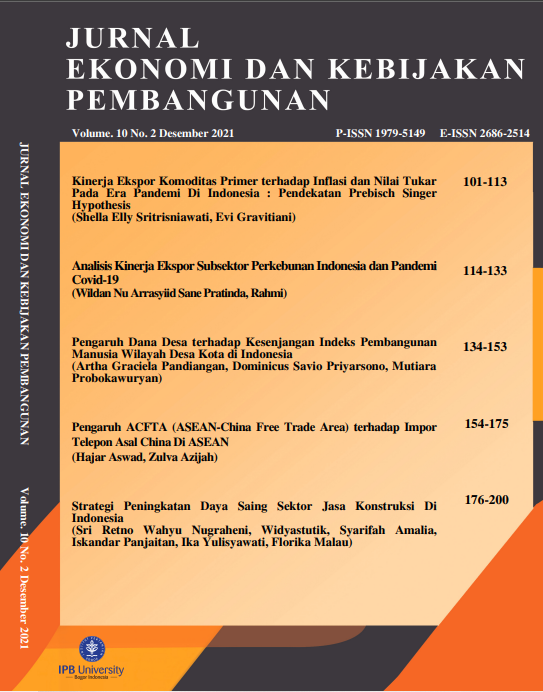Strategy to Improve the Competitiveness of Indonesian Construction Services Sector IPB University, Ministry of Trade
Abstract
The service sector is often associated with a countries economic's progress, where the more advanced a country, the greater its role in the service sector. Construction service is one of Indonesia's service sectors which has more than one forward and backward linkage value and shows that construction services are a key sector. However, the average growth of Indonesia's construction services exports during 2015-2020 was only 5.47 percent and still has the potential to be increased. Therefore, it is necessary to know the performance, comparative advantage, and competitive advantage of the construction services sector, which in turn needs to be formulated to increase the competitiveness of the sector. By using primary and secondary data, this study was analyzed using descriptive analysis, Export Product Dynamic (EPD), and Structural Equation Model (SEM). The results of the analysis show that the Indonesian construction services sector still has the opportunity to be developed as seen from the occurrence of excess demand, which indicates that the Indonesian construction market has not been fully exploited. The potential for developing exports of construction services with partner countries can be carried out by Indonesia with Australia, New Zealand, Japan, China, Korea, and several countries in Southeast Asia. The competitiveness of Indonesia's construction services sector is strongly affected by aspects of opportunity, regulation, and demand from partner countries. Therefore, several strategies that need to be carried out by Indonesia to increase the competitiveness of the construction services sector are determining priority partner countries, creating conducive conditions for political, security, economic, and business climate, strengthening and collaboration with Indonesian certification agency with the world of education, as well as strengthening business actors engaged in the service sector to be able to compete with competitors.
References
Basri F, Munandar H. 2010. Dasar-Dasar Ekonomi Internasional. Pengenalan dan Aplikasi Metode Kuantitatif. Edisi Pertama. Jakarta (ID: Kencana Prenada Media Group.
Dee, P. (2004). Measuring the Cost of Regulatory Restrictions on Services Trade in Malaysia, background report for a study on Improving the Investment Climate Regulatory Burden in Malaysia. Washington, D.C.: World Bank for the Economic Planning Unit of Malaysia. g Competitiveness in the Agribusiness Sector: Methodological and Analytical Framework. University of Pretoria.
Hayami, Y. and Godo, Y. 2005. Development Economics: From the Poverty to the Wealth of Nations. Oxford University Press, Oxford. http://dx.doi.org/10.1093/0199272700.001.0001
Hill TP. 1977. On Goods and Services. Review of Income and Wealth series 23, No 4.
Kalirajan K. 2000. Indian Ocean Rim Associaton for Regional Cooperation (IORARC): Impact on Australia’s Trade. JEI (15):533-547
Kementerian Perdagangan. (2013). Kajian Tinjauan Ulang Pemanfaatan Kerjasama IJEPA pada Sektor Jasa Indonesia. Laporan Kajian (Tidak dipublikasikan). Jakarta: Pusat Kebijakan Kerjasama Perdagangan Internasional, Kementerian Perdagangan
Kementerian Perdagangan. 2018. Laporan Kinerja Tahun 2018. Ditjen Perundingan Perdagangan Internasional - Kementerian Perdagangan, Jakarta.
Payne BK. 2001. Prejudice and perception: The role of automatic and controlled processes in misperceiving a weapon. Journal of Personality and Social Psychology, 81(2), 181–192. https://doi.org/10.1037/0022-3514.81.2.181
Shepherd, B dan Marrell, EVD. 2010. Trade in Services in the APEC Region: Patterns, Determinants, and Policy Implication. APEC Policy Support Unit.
Stern R dan Hoekman B. (1988). The Service Sector in Economic Structure and in International Transactions. in L. Castle and C. Findlay (eds.), Pacific Trade in Services. Sydney: Allen & Unwin.
Widyastutik, Puspitawati E, dan Fawaiq M. 2014. Analisis Dampak Implementasi Komitmen Indonesia di Sektor Jasa Konstruksi dalam Kerangka AFAS. Jurnal Ekonomi dan Pembangunan Indonesia. VOL 15 NO 1 (2014): Juli. Tersedia pada : https://jepi.fe.ui.ac.id/index.php/JEPI/article/view/446/163.
[WB] World Bank. 2018. Toward Inclusive Growth.
[WB] World Bank. 2021. Data Share Perdagangan Jasa terhadap PDB Indonesia dan Peer Countries. Tersedia pada: https://data.worldbank.org/indicator/BG.GSR.NFSV.GD.ZS
Authors

This work is licensed under a Creative Commons Attribution-NonCommercial-ShareAlike 4.0 International License.
The authors who publis article(s) in Jurnal Ekonomi and Kebijakan Pembangunan have to understand and agree that the copyright of article published is owned by Jurnal ekonomi and Kebijakan pembangunan including to reproduce, distribute and sell this journal to public.

